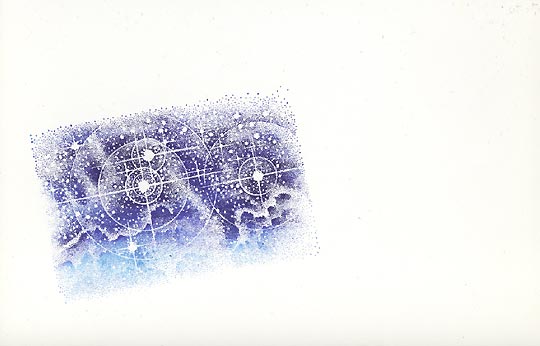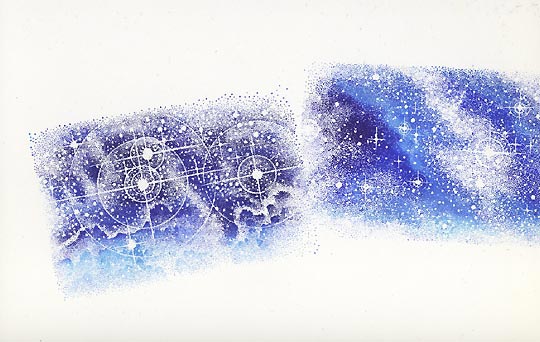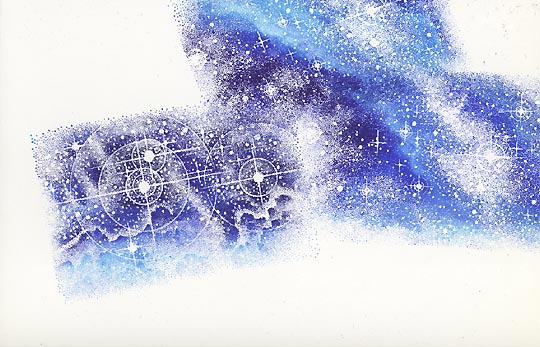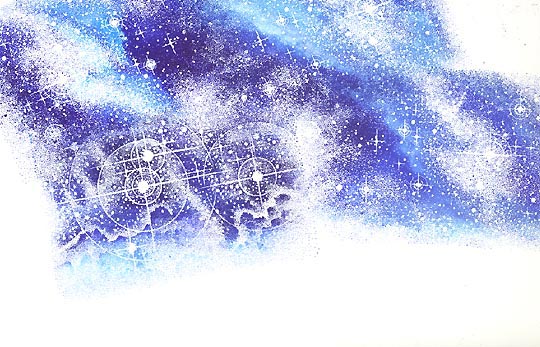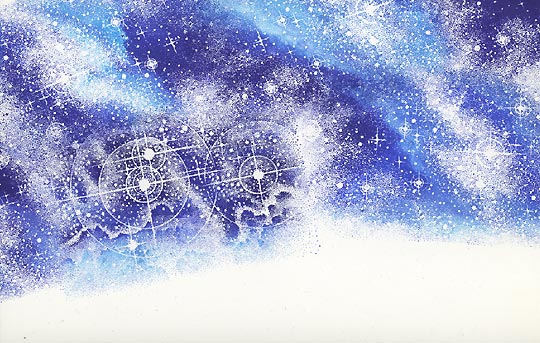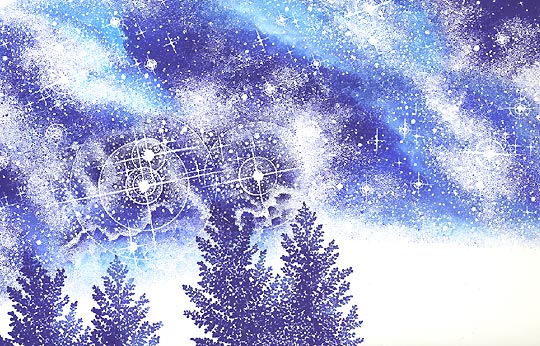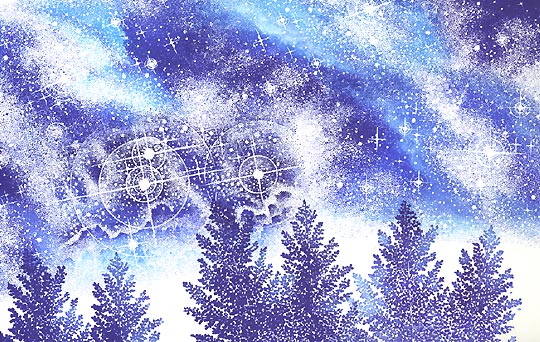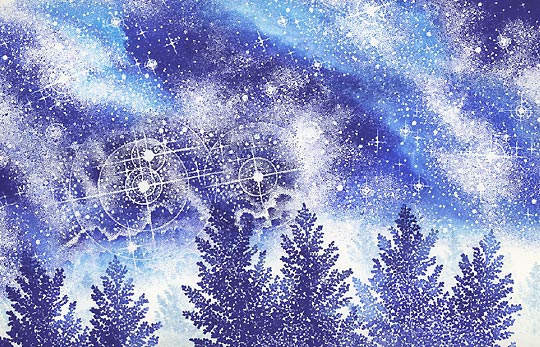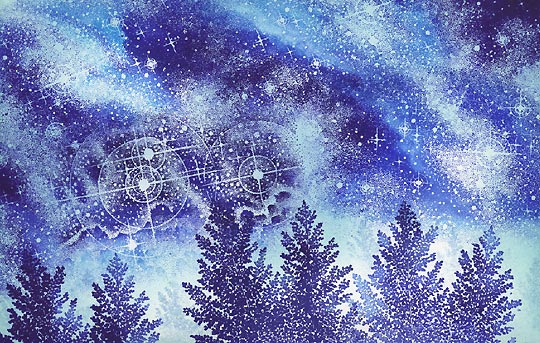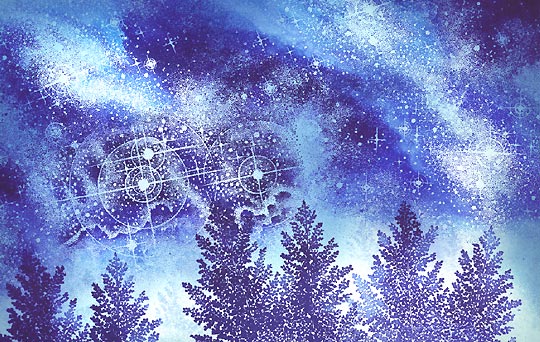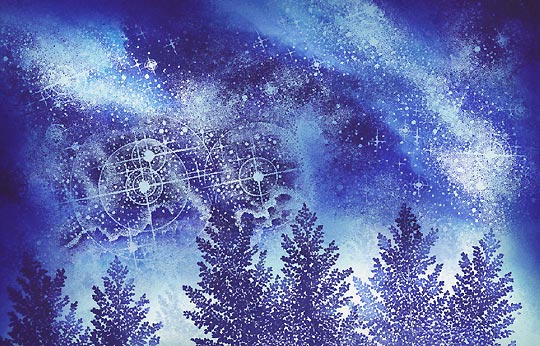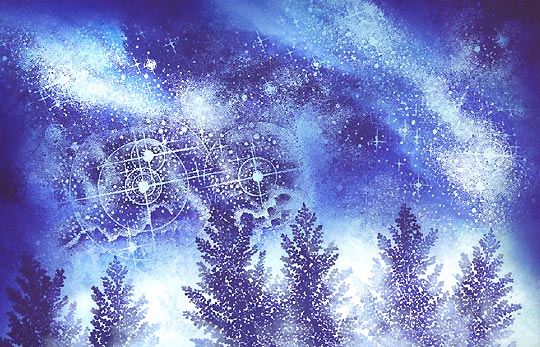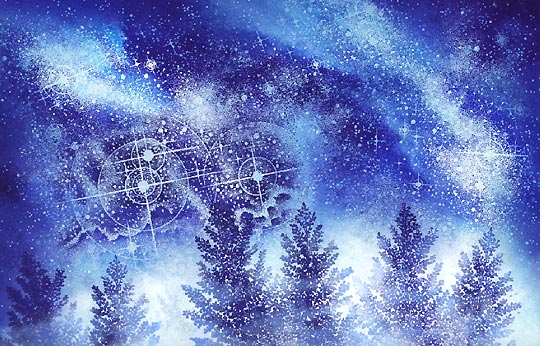Blue Mist
Star Birth-217G was stamped out in three blues -colored directly on to the rubber. Marvy Prussian Blue #29, Marvy Blue #3 and Marvy Light Blue #10 was used towards the bottom of the design. I knew I was going to add some trees later on so I wanted to keep it light down there.
The Milky Way Lg.-059G was colored the same way. I started with a Marvy Blue #3 went back in with a
Marvy Prussian Blue #29 in areas and then with a Marvy Manganese Blue #36. The Marvy #36 is the lightest of all
these blues and is the reason for that diagonal value transition just to the left of that band of
white stars in this image. With the Marvy #36, I kind of wiped off/lifted some of the darker inks off the rubber as I colored it with the lighter hue. Light into dark will avoid real streaky lines, but you have to do that lifting of the darker tones off the rubber to get that lighter tone when
making the impression. A juicy pen helps. If you use a semi-dry one, it will absorb ink into the tip -which you don't want.
Another Milky Way Lg. impression. You can see how I matched up the band of stars with the first M.W. Also, the light blue streaks match up. Note how the angle of the images are being stamped. I don't have these stacking on each other like bricks. I'm changing the angles slightly and overlapping previous impressions. In doing this, we avoid a situation where it looks like a jigsaw puzzle with lines in between the different impressions.
A third Milky Way Lg.-059G is added.
Two more impressions are made with the Milky Way to fill in the rest of the sky.
Two impressions of Quaking Aspen-238G are stamped in a Marvy Prussian Blue #29. A little variation in value is added to the trees by using a Marvy #53. You can see some of the tree tips are a little lighter.
Another tree added. Where it touches the existing tree I've dabbed off some of the ink before making the impression. This way we can show the distance between the trees by having one a little lighter --in that area.
Quaking Aspen Small-237E was stamped in the background in a Marvy Salvia Blue #60. This is somewhat of a dull (intensity-wise) and light color. Perfect for these distant trees. Again, I've mopped off some of the color, from the rubber, before making my impressions. This way, it looks like they're disappearing into some mist down below.
Ranger Industries -Sea Shells Ocean Aqua was applied with the Tonal Applicator-084E. A perfect light blue to start the toning process with --very light, very bright color. I want to bring some color into my scene but I'm keeping in mind that I want to keep some areas and some stars light so I'm not toning in those parts.
The Tonal Applicator was used in a Marvy Salvia Blue #60 here. The scene's starting to get a touch darker in the areas intended.
The Tonal Applicator was used in a Marvy Blue #3 and Marvy Prussian Blue #29 here and represents the last of the colors that I'll use in the layering process. Note how some of the bands of stars still show fairly light. I stayed away from those areas with the Tonal Applicator--except, maybe, with the lightest of the colors (first couple blues used).
A haze was added with some pigment ink --Colorbox Frost White and Tsukineko Brilliance Moonlight White. It was added in a dry brushing/dabbing technique. Very thin layers are built up over several applications. I find that the Tsukineko dries on the glossy paper well and the Colorbox takes a while. I like them both for their various properties. I want one that dries quickly, but I also want one that I can move around on the paper before it sets up too quickly. I've added these translucent pigment inks around some tree limbs as if some meandering fog is present.
Finally, more pigment ink haze was added in front of the near trees --in very light applications-- and additional stars were added back into the sky with gel pens. I used a pastel blue and white Milky Gel Roller. In the darker regions, where the gels were used, I used more blue than white. The white gel was used in the lighter areas. Also, highlighting was added to some areas of the tree leaves. Most of the trees were dark so I used the blue gel (see detail below).
